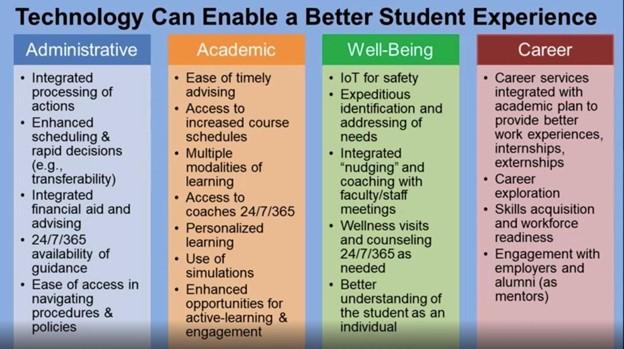College and university leaders fully understand that technology is paramount to the decision making process and the future of higher education.
“When we are talking about center stage, we are not talking about technology taking over. We are talking about technology being the enabler, technology being the one that allows us to do our work much better, faster, enabling our students to get far more from the experience, and enabling our faculty and staff to do what they do so well in a much better way,” said Dr. Vistasp M. Karbhari, President and Professor at the Department of Aerospace and Mechanical Engineering, President and Professor at the Department of Civil Engineering at the University of Texas at Arlington.
Dr. Karbhari kicked off with the keynote address at the recent Fierce Education’s virtual event Higher Education: Technology Profiles in Success - Spring Edition.
Dr. Karbhari referred to the fear of technology which has always been present in education and goes back to the times of Greek philosopher Socrates. “Socrates complained that being able to write was going to change the way — in a bad way — as to how people actually read and learn,” he said
From believing that the printed word was going to be the worst that could happen to scholars to thinking that all learning would end, society’s fear of technology went on to creating the Red Flag Law in the state of Vermont in 1894. “If you were in an automobile or if you were on a train there had to be a buzzer [carrying a red flag during the day and a red light at night] walking at least six feet ahead of you to warn everyone else about this great technology that is going to ruin everything […] And look at us today.”
“When the calculators were first introduced they were talked about as weapons of maths destruction because they would kill our ability, […] but with calculators and computers we’ve been able to fast-forward technology in a way that would have not been done before,” Dr. Karbhari said. The fear of technology went on to blame e-mail “to hurt IQ more than pot,” according to a past CNN.com article.
“Technology can be scary, it can cause fear, but if used properly it can really do the right thing for all of us as it is doing now in terms of academic life,” assured Dr. Karbhari.
Evolution in the dissemination of knowledge
- From a sage on the stage surrounded by three or four of his or her students
- To the use of books and Gothenburg press
- To large classrooms
- To the use of multimedia in the 1990s
- To online education
- To Zoom classrooms
- To adaptive learning and personalization
- To transition from local/regional access and bringing students to campus (smart campus)
- To enabling learners anywhere, anytime, and this is what technology makes possible
Dr. Karbhari reminded the audience about the evolution of campus itself going from a physical infrastructure to immersive education. “Space no longer defines campus. Technology can enlarge the “space,” increase access and engagement, effectiveness and efficiency.” Everything points out at Digital Transformation on campus.
Technology allows us to a change in approach
- From the assembly line approach: One size fits all paradigm where students are expected to be all the same, have the same needs, focus, goals, and learn at the same pace like machines where students receive the same information, at the same time, and the same pace
- To a flexible, more equitable model where learning can be based on ensuring engagement and support, be self-paced, adaptive, personalized, focused on the individual learner, with interaction that can be fully immersive, active, collaborative, and inquiry focused
Technology Evolution in Connectivity
Dr. Karbhari made it clear he was not just talking about the connectivity between a student and a faculty member but also about one office at an institution and another one, or between the place of work and where the students are going to go. “That connectivity is now more enabled through the use of technology, and we are able to get a student or rather a learner-centered focus,” he said. “We should move from pillar to post to seamless, integrated engagement and interaction.”
Technology can be an enabler of a better student experience at the administrative, academic, well-being, and career level.

Technology integrates and enables the knowledge enterprise
“This is what we bring together by the use of the right technology,” explains Dr. Karbhari while emphasizing that students should not feel that 30 to 40 percent of their knowledge is already obsolete by the time they graduate.
The 21st century university
Dr. Karbhari pointed out how dynamic engagement can be enabled across the board using Digital Twins for off-site immersion and for skills based learning. Augmented Reality and Virtual Reality (AR/VR) are now extensively used in nursing, medical, and veterinary degrees to simulate educational experiences. The use of simulations go beyond science and technology. Historical events, archeology, and virtually any other discipline can benefit from the use of simulations.
There is a lot of fear of Artificial Intelligence (AI) and ChatGPT, however, Dr. Karbhari gave examples of applications where this generative AI technology can be used very well in the teaching and learning environment. “We have to be careful and don’t blame technology when things go wrong but blame ourselves for not doing the right thing.”
AI, as with all other technology, must be handled with care since AI can create its own information, said Dr. Karbhari. Technology, when used right, can make a tremendous difference to us, it can cause a positive change to the traditional campus.
The full keynote address and other presentations part of the event can be viewed on-demand here
For more articles from the online event, see:
Ensuring Engagement: Reaching and Keeping Students’ Attention